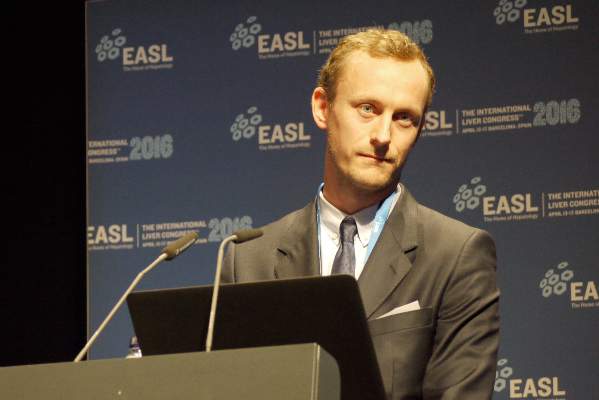AT THE INTERNATIONAL LIVER CONGRESS 2016
BARCELONA (FRONTLINE MEDICAL NEWS) – Although a new histological scoring system was able to predict mortality from nonalcoholic fatty liver disease (NAFLD), fibrosis remains the key predictor of whether an individual is likely to die decades later.
Patients with severe NAFLD, as determined by having a high steatosis, activity, and fibrosis (SAF)score, were more than twice as likely to die than those with mild-to-moderate disease up to 41 years later.
However, when a sensitivity analysis was performed to adjust for fibrosis stage or exclude patients with stage 3-4 fibrosis, the hazard ratio for mortality was no longer significant.
“Severe SAF score was associated with increased mortality, but this largely depended on fibrosis stage,” Dr. Hannes Hagström of the Karolinska Institutet in Stockholm reported at the International Liver Congress.
Although it is known that the more severe the disease the more likely the risk for death, assessing the severity of NAFLD can be challenging for clinicians because it is a continuum of disease,he explained. “NAFLD is the most prevalent liver disease globally with a prevalence of around 25%; it is very heterogeneous and makes prognostication difficult.” This has implications for including people in trials and for determining what the clinical endpoints should be, as well as making it difficult to determine the outlook for individual patients.
There are several histological scoring systems developed over the years trying to help with this issue, including the Brunt score, the NAFLD activity score (NAS), and fibrosis stage.
While the latter has previously been shown to be a robust marker for mortality, the NAS has been criticized, Dr. Hagström noted. This is because the effect of steatosis may be overestimated and because NAS does not measure fibrosis. Thus, there is a need for new means to risk-stratify patients and one relatively new method is the SAF score.
The SAF score was developed to evaluate the severity of fatty liver lesions, originally in morbidly obese individuals ( Hepatology. 2012 Oct;56:1751-9 ). Using this score, the extent of fatty accumulation in the liver can be assessed, with a score of 0 signifying that steatosis is present in less than 5% of the liver and a score of 3 signifying that more than two-thirds of the liver is affected. NAFLD activity is determined on a scale of 0 to 4 by assessing the degree of ballooning and lobular inflammation. Finally, the score looks at the extent of fibrosis, rating it from 0 (not present) to 4 (cirrhosis).
The aim of the study was to examine the impact of this score on overall mortality in a previously published ( Hepatology. 2015 Mar;61:1547-54 ) cohort of patients with long follow-up, Dr. Hagström explained at the meeting sponsored by the European Association for the Study of the Liver (EASL). Data on 139 patients with biopsy-proven NAFLD were obtained from a historical cohort of patients who had undergone liver biopsy between 1974 and 1994. Their biopsies were reclassified using the SAF score and the presence of nonalcoholic steatohepatitis was also determined using the FLIP algorithm and the NAS score. Data on causes of death were taken from a national Swedish population register. At baseline, 35 patients had mild, 35 had moderate, and 69 had severe NAFLD.
After a median follow-up of 25 years, ranging from 2 to 41 years, 74 patients died. Of these deaths, 45 occurred in patients with severe NAFLD, representing 65% of the severe NAFLD group. Half (n = 18; 51%) of the patients with moderate NAFLD and just under one-third (n = 11; 31%) of those with mild NAFLD had also died. The median time to death was 18 years after liver biopsy.
Dr. Hagström reported that cardiovascular causes were the main cause of mortality, in 21% of patients; extrahepatic malignancy caused 12% of deaths, 7% of deaths were liver related, and 13% were due to other reasons. Patients with severe NAFLD identified by a high SAF score were more than two and a half times more likely to die than those with mild NAFLD, with a hazard ratio of 2.65 (P = .02). Patients with moderate NAFLD were no more likely than those with mild liver disease to die (HR = 1.23; P = .84). Data had been adjusted for gender, body mass index, and for the presence of type 2 diabetes.
HRs for mortality comparing high with low SAF scores after adjusting for fibrosis stage and excluding patients with fibrosis stages 3-4 were a respective 1.85 (P = .18) and 1.94 (P = .15). In a press statement issued by EASL, Dr. Laurent Castera of Hôpital Beaujon in Paris noted that these data were an important step forward for the medical community in being able to identify the patients who are most at risk of death from NAFLD. Dr. Castera, who is the secretary general of EASL, noted that these long-term study data also demonstrated the importance of having sufficient follow-up periods for patients with NAFLD.
In an interview after his presentation Dr. Hagström also emphasized the importance of long-term follow-up of patients.
“The clinical importance of this is that it is most important for clinicians to look at fibrosis stage, and I think to have to follow these patients a little bit more,” he said. “You can’t just do a liver biopsy, say ‘you just have steatosis, you don’t have NASH [nonalcoholic steatohepatitis], [so] you are fine’,” he added. Equally, it is not possible to say that because NASH is not present that patients won’t advance in the future. Patients need to be followed up for a long period of time.
“Fibrosis is the most important thing, both for clinicians and for patients,” Dr. Hagström said.Dr. Hagström has been a consultant to Novo Nordisk. Dr. Castera had no relevant financial disclosures.





